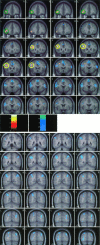Prefrontal cortex involvement in processing incorrect arithmetic equations: evidence from event-related fMRI
- PMID: 11954061
- PMCID: PMC6871871
- DOI: 10.1002/hbm.10035
Prefrontal cortex involvement in processing incorrect arithmetic equations: evidence from event-related fMRI
Abstract
The main aim of this study was to investigate the differential processing of correct and incorrect equations to gain further insight into the neural processes involved in arithmetic reasoning. Electrophysiological studies in humans have demonstrated that processing incorrect arithmetic equations (e.g., 2 + 2 = 5) elicits a prominent event-related potential (ERP) compared to processing correct equations (e.g., 2 + 2 = 4). In the present study, we investigated the neural substrates of this process using event-related functional magnetic resonance imaging (fMRI). Subjects were presented with arithmetic equations and asked to indicate whether the solution displayed was correct or incorrect. We found greater activation to incorrect, compared to correct equations, in the left dorsolateral prefrontal cortex (DLPFC, BA 46) and the left ventrolateral prefrontal cortex (VLPFC, BA 47). Our results provide the first brain imaging evidence for differential processing of incorrect vs. correct equations. The prefrontal cortex activation observed in processing incorrect equations overlaps with brain areas known to be involved in working memory and interference processing. The DLPFC region differentially activated by incorrect equations was also involved in overall arithmetic processing, whereas the VLPFC was activated only during the differential processing of incorrect equations. Differential response to correct and incorrect arithmetic equations was not observed in parietal cortex regions such as the angular gyrus and intra-parietal sulcus, which are known to play a specific role in performing arithmetic computations. The pattern of brain response observed is consistent with the hypothesis that processing incorrect equations involves detection of an incorrect answer and resolution of the interference between the internally computed and externally presented incorrect answer. More specifically, greater activation during processing of incorrect equations appears to reflect additional operations involved in maintaining the results in working memory, while subjects attempt to resolve the conflict and select a response. These findings allow us to further delineate and dissociate the contributions of prefrontal and parietal cortices to arithmetic reasoning.
Copyright 2002 Wiley-Liss, Inc.
Figures




References
-
- Allen PA, Smith AF, Jerge KA, Vires‐Collins H (1997): Age differences in mental multiplication: evidence for peripheral but not central decrements. J Gerontol B Psychol Sci Soc Sci 52: 81–90. - PubMed
-
- Burbaud P, Degreze P, Lafon P, Franconi JM, Bouligand B, Bioulac B, Caille JM, Allard M (1995): Lateralization of prefrontal activation during internal mental calculation: a functional magnetic resonance imaging study. J Neurophysiol 74: 2194–2200. - PubMed
-
- Burock MA, Buckner RL, Woldorff MG, Rosen BR, Dale AM (1998): Randomized event‐related experimental designs allow for extremely rapid presentation rates using functional MRI. Neuroreport 9: 3735–3739. - PubMed
-
- Clark VP, Maisog JM, Haxby JV (1998): fMRI study of face perception and memory using random stimulus sequences. J Neurophysiol 79: 3257–3265. - PubMed
Publication types
MeSH terms
Grants and funding
LinkOut - more resources
Full Text Sources

